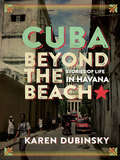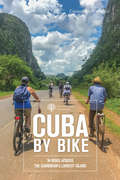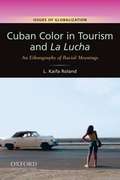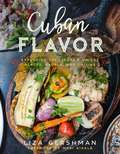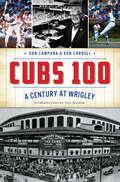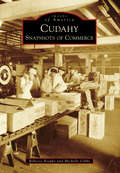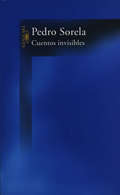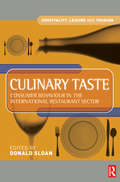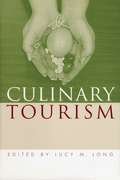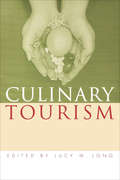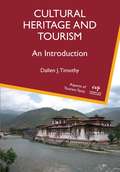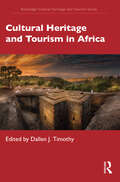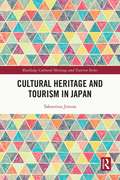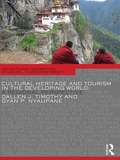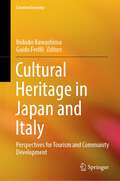- Table View
- List View
Cuba beyond the Beach: Stories of Life in Havana
by Karen DubinskyHavana is Cuba’s soul: a mix of Third World, First World, and Other World. After over a decade of visits as a teacher, researcher, and friend, Karen Dubinsky looks past political slogans and tourist postcards to the streets, neighbourhoods, and personalities of a complicated and contradictory city. Her affectionate, humorous vignettes illustrate how Havana’s residents—old Communist ladies, their sceptical offspring, musicians, underground vendors, entrepreneurial landlords, and poverty-stricken professors—go about their daily lives. As Cuba undergoes dramatic change, there is much to appreciate, and learn from, in the unlikely world Cubans have collectively built for themselves. A portion of the proceeds from the sale of this book will go to the Queen’s University Student Overseas Travel Fund—The Sonia Enjamio Fund, which funds Cuban/Canadian student exchange.
Cuba by Bike: 36 Bike Rides From Cienfuegos To Pinar Del Rio
by Cassandra BrooklynA cyclist’s guide to the best of Cuba Cuba is continuing to see a big upswing in American and Canadian tourism since relations between the nations were relaxed a couple years ago. As locals and thrifty travelers know, the cheapest, healthiest, most scenic—and often fastest—way to travel in Cuba is by bicycle. The rides vary in length, many combining to create multiday loops. Detailed directions describe rides leaving Havana to the west and east. Subsequent rides are clustered in the three best regions of Cuba for cycling: Pinar del Rio, Central Cuba, and the Oriente. Organized cleverly by regions outside Havana that are just made for cycling, this guide will include 36 rides that make the most of every mile. In addition to directions, maps, and a scenic itinerary for each ride, there will also be crucial information for the bicycling traveler, including where to get supplies and equipment, how to safely park your bike, safety tips, and more.
Cuba hasta siempre
by Magdalena SoléMagdalena Solé first visited Cuba in 2011 and has returned every year since, enchanted by the place and the people who live in this slender stretch of land. Her photographs reveal the stirrings of transformation, however subtle and hard to see, and reflect a Cuba that is both tough and vulnerable. Cuba hasta siempre consists of more than 150 full-color photographs taken by Solé, accompanied by a foreword written by Time columnist and travel writer Pico Iyer. With minimal text, this book offers a view of Cuba beyond the tourist trade and the wealthy upper class. The photographs portray everyday settings and people engaged in daily tasks. A visual encounter with magical realism, this collection constructs an atmosphere of pervasive timelessness, a photographic time capsule. Memorabilia and objects from Cuba’s revolutionary past linger in the present, while life goes on. These soulful images offer a new visual perspective on Cuba past and present. The Wall Street Journal called Solé’s images “lushly colorful,” “formally striking,” “restless,” and “electrify[ing].”
Cuba in Mind: An Anthology
by Maria Finn DominguezSince Columbus arrived in 1492 and called Cuba “the most beautiful country that human eyes have ever seen,” few places on earth have evoked such passion. The thirty-one writers inCuba in Mindoffer ample proof of the fascinations that have lured generations of travelers. In this richly varied anthology of poetry, fiction, and nonfiction, we hear from such famous visitors as Anthony Trollope, Langston Hughes, Ernest Hemingway, and Graham Greene. Poets and journalists offer their responses, from Allen Ginsberg and Jayne Cortez to Alma Guillermoprieto and Robert Stone; and novelists weigh in with such fictional portrayals as Elmore Leonard’sCuba Libreand Pico Iyer’sCuba and the Night. Cuban exiles, immigrants, and their offspring provide their unique perspective, from Cristina García’s essay “Simple Life” to excerpts from Oscar Hijuelos’s novelThe Mambo Kings Play Songs of Loveand from Carlos Eire’s memoirWaiting for Snow in Havana. Embracing salsa and santeria, politics and baseball, the island’s sparkling beaches and the teeming Havana streets,Cuba in Mindcaptures the vibrancy, the contradictions, the heat and the humor of Cuba as shown by some of the best writers in the English language. Contributors: Thomas Barbour • José Barreiro • Ruth Behar • William Cullen Bryant • Jayne Cortez • Stephen Crane • Andrei Codrescu • Eleanor Early • Carlos Eire • Kimi Eisele • Cristina García • Allen Ginsberg • Graham Greene • Alma Guillermoprieto • Elizabeth Hanly • Ernest Hemingway • Consuelo Hermer • Oscar Hijuelos • Langston Hughes • Pico Iyer • Elmore Leonard • Rosa Lowinger • Marjorie May • Tom Miller • Holly Morris • Ricardo Pau-Llosa • Robert Stone • Jim Shepard • Isadora Tattlin • Anthony Trollope • Walter D. Wilcox
Cuba: A Journey Through Modern Cuba
by Stephen SmithFor a growing number of British holidaymakers, Cuba is a Caribbean paradise, but it is also a land of cutbacks and economic instability. Stephen Smith comes to live on the island, and his search for the real Cuba inevitably becomes a search for Fidel Castro too. Before meeting his quarry, Smith travels extensively through the 'land of miracles' in an old American automobile. His highly-personalised account features a bloody initiation into a voodoo-like cult, dining on giant rat, and checking into the Love Hotel. And he goes on manoeuvres in the Everglades with armed, but not especially competent, Cuban exiles dreaming of a second Bay of Pigs. With disarming wit and considerable insight, Stephen Smith investigates a country where communism and voodoo coexist, and where the influence of its leader of forty years continues to throw a long shadow.
Cuba: A Journey Through Modern Cuba
by Stephen SmithFor a growing number of British holidaymakers, Cuba is a Caribbean paradise, but it is also a land of cutbacks and economic instability. Stephen Smith comes to live on the island, and his search for the real Cuba inevitably becomes a search for Fidel Castro too. Before meeting his quarry, Smith travels extensively through the 'land of miracles' in an old American automobile. His highly-personalised account features a bloody initiation into a voodoo-like cult, dining on giant rat, and checking into the Love Hotel. And he goes on manoeuvres in the Everglades with armed, but not especially competent, Cuban exiles dreaming of a second Bay of Pigs. With disarming wit and considerable insight, Stephen Smith investigates a country where communism and voodoo coexist, and where the influence of its leader of forty years continues to throw a long shadow.
Cuban Color in Tourism and La Lucha: An Ethnography of Racial Meanings
by L. Kaifa RolandThis book explores the tensions and contradictions of post-Soviet-era Cuba's use of tourism, a fundamentally capitalist tool, to sustain its socialist economy.
Cuban Flavor: Exploring the Island's Unique Places, People, and Cuisine
by Liza Gershman Mari AixaláA lush journey through Cuba, its paladars, and its flavorful cuisine For Cubans, food is a complex story—a tapestry of love and loss woven so deeply into their culture that it goes well beyond that of history or sustenance. Gershman, who’s love affair with Cuba began long before her first visit, takes you along on a photojournalistic journey through the streets of Cuba and its paladares through her stunning photographs of the country’s glorious sights, the lively people, and, of course, the amazing variety of food. Much more than a cookbook, Cuban Flavor is an introduction to a revolutionary era of Cuban cuisine: a new frontier. Growth and transition foster the seed of invention and innovation, and these shifts often begin with food. From the succulent spiced meat of the national Ropa Viejo, simmered in a tomato-based criollo sauce, to the sweet and sticky Arroz Con Leche or the local favorite, Flan served in a soda can, Cuban cuisine has something for every palate. Pair these delights with a warm, sultry night, an old convertible, and a jazz band, and sit back as you fall deeply in love again . . . or for the very first time. This visually arresting volume features more than fifty Cuban recipes, from appetizers to main courses and drinks to desserts. Along with color photographs of the dishes, you’ll also get to meet the people who create them. This remarkable volume offers a taste of the little-known culture to a public that has long been deprived of its intoxicating flavors.
Cubs 100: A Century at Wrigley
by Rob Carroll Dan CampanaThe Cubs have called Wrigley their home since 1916 and have treated their loyal followers with memories that have lasted for generations. From the legend of Babe Ruth's called shot to Kerry Wood's dominant twenty-strikeout performance, great games, notable names and a multitude of memorable moments have played out at Clark and Addison to create baseball's most recognizable relationship: the Cubs and Wrigley Field. The authors of Wrigley Field: 100 Stories for 100 Years return to celebrate this grand anniversary with Cubs 100: A Century at Wrigley, a new collection of baseball tales, including highlights from the exciting 2015 season, from storytellers such as Ryne Sandberg, Andre Dawson, Len Kasper and many others who know the symbiotic connection between the historic franchise and its iconic home.
Cudahy: Snapshots of Commerce (Images of America)
by Michelle Gibbs Rebecca RoepkeCudahy's commerce began with Patrick Cudahy, an Irish immigrant who started a meatpacking business in 1892. He invited other industrialists to follow him to the farmlands southeast of Milwaukee, and soon nationally known companies like Ladish, Federal Rubber, and George Meyer opened factories in the new city. Smaller businesses like Adamczyk's Meat Market, Dretzka's Department Store, Pinter's Inn, and Sullivan's Cigar Shop thrived amidst a growing population. With the gradual loss of heavy industry after World War II and the rise of retail box stores, Cudahy has strived to attract commercial and light manufacturing companies like the Gift Shoppe, Milwaukee Cylinder, National Tissue, and Angelic Bakehouse. Cudahy started as--and continues to be--a small town with big opportunities.
Cuentos invisibles
by Pedro SorelaPedro Sorela emprende en estas páginas su viaje más largo: la distancia que separa un cuento de su historia. Estos cuentos son invisibles porque invisible es el lenguaje de la literatura, que no se puede filmar. También porque tratan de viajes, y el viaje es lo que se encuentra detrás de los ojos, no delante, y -al igual que la literatura- hace posible que de nuestra visión del mundo hagamos una creación. De una represa de aguas milenarias en la cima de los Andes a un motín de blancos en un río chino, de una persecución en Londres al renacimiento de un pobre tipo en Estambul, de una reunión de extravagantes en Helsinki a un Berlín improbable y sin embargo histórico, de un Madrid inédito a un Buenos Aires francés, los cuentos de Pedro Sorela ponen en evidencia el lado mentiroso de los pasaportes. Con humor y un idioma afilado, estos cuentos amplían el arco de una obra definida por la originalidad de la mirada y la sugerencia inherente a su doble condición de literatura y viaje. Reseñas:«Una experiencia humana intensa [...] un periplo abarcador de la existencia humana en el que entran componentes culturales, morales y hasta políticos, éstos no explícitos pero sí intencionados».Santos Sans Villaneva, El Cultural «Los relatos de Sorela prueban que ha viajado lo bastante para, como hubiera dicho Valle-Inclán, no ser arrogante cuando bien podría serlo».Víctor Andresco, El País
Culinary Creation
by James MorganThe book seeks not to present a detailed history and discussion, but instead is intended to provide the student with an appreciation of the idea that all cuisines of the world have something unique to offer to a menu. The author strongly believes that foods of other nations (and even other areas of the United States) are too often given short shrift by culture-bound students and chefs, and that every attempt should be made to open their minds to the unlimited possibilities available. The word “foodism” is introduced to refer to biases against foods outside your culture.
Culinary History of Cape May, A: Salt Oysters, Beach Plums & Cabernet Franc (American Palate)
by John Howard-FuscoCape May is America’s first seaside resort, and with that comes a mouthwatering food history. The New York Times even proclaimed the city “Restaurant Capital of New Jersey.” The first settlers, the Kechemeche of the Lenape tribe, feasted on the fish and wild game in the area. The whaling industry briefly brought attention to the island, but Ellis Hughes’s 1801 advertisement offering seashore entertainment with “fish, oysters, crabs, and good liquors” gave birth to a beachside haven. From the mint juleps to the Sunny Hall Café and the Chalfonte, culinary creativity thrives on the shore. Modern chefs like Lucas Manteca at the Red Store and Brooke Dodds’s Empanada Mamas help keep the unique flair alive. Author John Howard-Fusco traces the roots of the delectable dishes and recipes from long ago to the modern day.
Culinary Taste: Consumer Behaviour In The International Restaurant Sector (Hospitality, Leisure And Tourism Ser.)
by Prue Leith Donald SloanCulinary Taste: Consumer Behaviour in the International Restaurant Sector looks at the factors that influence our culinary tastes and dining behaviour, illustrating how they can translate into successful business in industry.With a foreword from Prue Leith, restaurateur, author, teacher, and prolific cookery writer and novelist, and a list of well-known and respected international contributors from the UK, France, Australia and Hong Kong, this text discusses the issues involved from a multitude of angles.
Culinary Tourism
by Lucy M. LongCulinary Tourism is the first book to consider food as both a destination and a means for tourism. The book's contributors examine the many intersections of food, culture and tourism in public and commercial contexts, in private and domestic settings, and around the world. The contributors argue that the sensory experience of eating provides people with a unique means of communication. Editor Lucy Long contends that although the interest in experiencing ""otherness"" is strong within American society, total immersion into the unfamiliar is not always welcome. Thus spicy flavors of Latin Aermcia and the exotic ingredients of Asia have been mainstreamed for everyday consumption. Culinary Tourism explains how and why interest in foreign food is expanding tastes and leading to commercial profit in America, but the book also show how tourism combines personal experiences with cultural and social attitudes toward food and the circumstances for adventurous eating.
Culinary Tourism (Material Worlds)
by Lucy M. Long&“Well-researched and original&” essays on the intersection between food and adventure (Publishers Weekly). Culinary Tourism is the first book to consider food as both a destination and a means for tourism. The book&’s contributors examine the many intersections of food, culture, and tourism in public and commercial contexts, in private and domestic settings, and around the world. The contributors argue that the sensory experience of eating provides people with a unique means of communication—whether they&’re trying out a new kind of ethnic restaurant in their own town or the native cuisine of a place far from home. Editor Lucy Long explains how and why interest in foreign food is expanding tastes and leading to commercial profit in America, but the book also shows how tourism combines personal experiences with cultural and social attitudes toward food and the circumstances that allow for adventurous eating. &“Contributors to the book are widely recognized food experts who encourage readers to venture outside the comforts of home and embark on new eating experiences.&” —Lexington Herald-Leader
Culloden, 1746: Battlefield Guide: Third Edition (Battleground Scotland Ser.)
by Stuart ReidA journey to the Highland battlefield where this landmark event in Scottish history took place, with numerous maps and illustrations. Culloden Moor is one of the most famous battles in British history and, for the Scots, the battle is pre-eminent, surpassing even Bannockburn. In this decisive and bloody encounter in 1746, the Duke of Cumberland&’s government army defeated the Jacobite rebels led by Prince Charles Edward Stuart. Yet, despite the attention paid to this critical event—in particular to Bonnie Prince Charlie and the Jacobite legend—few writers have concentrated on the battle itself and on the Highland battlefield on which it was fought. Stuart Reid, in this revised third edition of his bestselling guide, does just that. He tells the story of the campaign and sets out in a graphic and easily understood way the movements and deployments of the opposing forces, and he describes in vivid detail the deadly combat that followed. Incorporating the latest documentary and archaeological research and featuring a completely new and expanded section on the armies, it also invites visitors to explore for themselves this historic ground on which the tragic battle was fought.
Cultural Due Diligence in Hospitality Ventures
by Nicole HäuslerThis book introduces readers to a powerful method for cross-cultural due diligence in mergers and organizational collaborations. It employs the context of joint ventures between local communities and companies in the domain of hospitality in emerging tourism destinations. The book first analyzes the impact of cultural diversity in mergers between local communities and the private sector, revealing the characteristics and functions of culture and paying specific attention to the roles of organizational and community cultures in hospitality. In two subsequent methodological chapters the book presents a theoretical framework for cultural due diligence and identifies the principal actors, technical aspects and core principles. On the basis of a separate case study from northern Thailand, the book provides an example of cultural context analysis and presents the findings and results. In a concluding chapter the book presents an outlook on further research and development in this field.
Cultural Heritage
by Michael Beverland Adam Lindgreen Adriana Campelo Laura ReynoldsCultural Heritage is a systematic, interdisciplinary examination of cultural heritage, which provides an up-to-date view of the field by drawing on various disciplines. The book offers a thorough, structured review of extant literature on heritage in tourism and pertinent challenges for cultural heritage. This book offers new ways of looking at cultural heritage assets against a backdrop of increasing economic and environmental pressures. It comprises a number of sections that each examine cultural heritage from the perspective of ethics and values, community relations and development, cultural entrepreneurship, economic viability and conservation, methodologies, impacts of tourism research, consumption, and urban and immaterial heritage. Encompassing global research perspectives from public management, visual culture, environmental management, and cultural entrepreneurship, Cultural Heritage is a crucial text for those working or interested in the heritage field.
Cultural Heritage Tourism Leadership: Perspectives on Human Dignity (Routledge Cultural Heritage and Tourism Series)
by Mark L. PickelThis book proposes a novel transformational humanistic leadership approach applied to cultural heritage tourism, based on humanistic values of human dignity, creativity, and autonomy and supported by a distinctive leadership ethos, purpose, and guiding principles that promote the betterment of society.By reimagining how cultural heritage tourism leadership upholds human dignity through tour experiences that generate moments of grounding, reflection, understanding, and healing, humanistic leadership provides an ethical framework and strategic alignment to encourage human flourishing. In proposing a pluralistic leadership ethic that unites social, ecological, and technological influences, the impact of cultural heritage tourism on visitors’ human dignity is considered, culminating in transformational humanistic leadership that promotes tourism sustainability, authenticity, and adaptability. Practical leadership challenges are explored through case studies and leadership inquiries that reflect the cultural complexity of international heritage tourism, including Avebury Neolithic stone henge in the United Kingdom, Caerleon Roman Fortress and Baths in Wales, the Museum of the Cherokee People in the United States, and the Meissen Porcelain Manufactory in Germany.Cultural heritage tourism leaders, public history and anthropology scholars, those interested in applied humanism in heritage contexts, and leadership ethicists will benefit from reflecting on human dignity as a central tenant of transformational humanistic leadership.
Cultural Heritage and Tourism
by Dallen J. TimothyOne of the most salient forms of modern-day tourism is based on the heritage of humankind. The majority of all global travel entails some element of the cultural past, as hundreds of millions of people visit cultural attractions, heritage festivals, and historic places each year. The book delves into this vast form of tourism by providing a comprehensive examination of its issues, current debates, concepts and practices. It looks at the social, physical and economic impacts, which cause destinations, site managers and interpreters to consider not only how to plan and manage resources but also how to portray the past in ways that are acceptable, accurate, accessible and politically relevant. In the process, however, the depth of heritage politics, the authenticity and inauthenticity of place and experience, and the urgent need to protect living and built cultures are exposed. The book explores these and many other current issues surrounding the management of cultural resources for tourism. In order to help students relate concepts to real-world situations it combines theory and practice, is student learning oriented, is written accessibly for all readers and is empirically rich.
Cultural Heritage and Tourism in Africa (Routledge Cultural Heritage and Tourism Series)
by Dallen J. TimothyCultural Heritage and Tourism in Africa examines the multiple and diverse manifestations of cultural heritage-based tourism in Africa from a regional, social science, and sustainability perspective. This book delivers a comprehensive treatise on the interdependent concepts of cultural heritage and tourism. Heritage is one of the most pervasive tourism assets worldwide and lies at the foundations of tourism in many localities, including Africa. However, despite its salience, there has not been a systematic examination of Africa’s heritage resources, markets, policies, practices, successes, and challenges in a tourism framework, despite the continent’s immense heritage value. This book reviews the different types of heritages that pervade the cultural environment of Africa and comprises its vast heritagescapes. It also examines the increasing potential for the growth of heritage tourism throughout the entire continent. The contributions in this volume delve into current thinking about space and place and their effects on heritage, mobilities, globalization, colonialism and indigeneity, conflict, identity and nation-building, connections with other regions through migration and the slave trade, and a greater emphasis on the ordinary heritage of Africa, which has long been ignored by tourism scholars and industry representatives. The chapters herein are authored by Africa specialists, most being from Africa, offering a truly African perspective. The chapters are conceptually rigorous and empirically rich with examples from all regions of the African continent. This unparalleled interdisciplinary glimpse at cultural heritage and tourism in Africa delivers strong value and is a vital resource for all students and researchers of tourism, cultural studies, heritage studies, geography, anthropology, sociology, history, and global studies.
Cultural Heritage and Tourism in Japan (Routledge Cultural Heritage and Tourism Series)
by Takamitsu JimuraThis book offers a comprehensive understanding of cultural heritage in Japan and its relationship with both domestic and international tourism. Japan has witnessed an increase in tourism, with rising visitor numbers to both established destinations and lesser known sites. This has generated greater attention towards various aspects of Japanese culture, heritage and society. This book explores these diverse aspects of everyday life in Japan and their interconnections with tourism. It begins with a conceptual framework of key theories related to heritage and tourism, serving as a useful apparatus for further discussions in the following chapters. Each chapter studies a specific aspect of Japan’s cultural heritage, from the history of Japan, the development of war sites, such as Hiroshima and Nagasaki, to tourist destinations, indigenous communities and their places of residence, festivals such as matsuri, to popular culture and media. Each chapter discusses a certain type of cultural heritage first in a global context and then examines it in a Japanese context, aiming to demonstrate the relation between these two different contexts. In each chapter, furthermore, how a particular kind of Japan’s cultural heritage is utilised as tourism resources and how it is perceived and consumed by international and domestic tourists are discussed. Finally, the book revisits the conceptual framework to suggest future directions for cultural heritage and tourism in Japan. Written in an informative and accessible style, this book will be of interest to scholars, students and practitioners in the fields of tourism, cultural studies and heritage studies.
Cultural Heritage and Tourism in the Developing World: A Regional Perspective (Contemporary Geographies of Leisure, Tourism and Mobility)
by Dallen J. Timothy Gyan P. NyaupaneCultural Heritage and Tourism in the Developing World is the first book of its kind to synthesize global and regional issues, challenges, and practices related to cultural heritage and tourism, specifically in less-developed nations. The importance of preservation and management of cultural heritage has been realized as an increasing number of tourists are visiting heritage attractions. Although many of the issues and challenges developing countries face in terms of heritage management are quite different from those in the developed world, there is a lack of consolidated research on this important subject. This seminal book tackles the issues through theoretical discourse, ideas and problems that underlay heritage tourism in terms of conservation, management, economics and underdevelopment, politics and power, resource utilization, colonialism, and various other antecedent notions that have shaped the development of heritage tourism in the less-developed regions of the world. The book is comprised of two sections. The first section highlights the broader conceptual underpinnings, debates, and paradigms in the realm of heritage tourism in developing regions. The chapters of this section examine heritage resources and the tourism product; protecting heritage relics, places and traditions; politics of heritage; and the impacts of heritage tourism. The second section examines heritage tourism issues in specific regions, including the Pacific Islands, South Asia, the Caribbean, China and Northeast Asia, South-East Asia, Sub-Saharan Africa, Central and Eastern Europe, the Middle East and North Africa, and Latin America. Each region has unique histories, cultures, political traditions, heritages, issues and problems, and the way these issues are tackled vary from place to place. This volume develops frameworks that are useful tools for heritage managers, planners and policy-makers, researchers, and students in understanding the complexity of cultural heritage and tourism in the developing world. Unlike many other books written about developing regions, this book provides insiders’ perspectives, as most of the empirical chapters are authored by the individuals who live or have lived in the various regions and have a greater understanding of the region’s culture, history, and operational frameworks in the realm of cultural heritage. The richness of this ‘indigenous’ or expert knowledge comes through as each regional overview elucidates the primary challenges and opportunities facing heritage and tourism managers in the less affluent areas of the world.
Cultural Heritage in Japan and Italy: Perspectives for Tourism and Community Development (Creative Economy)
by Nobuko Kawashima Guido FerilliThis edited book represents one of the first scholarly research through an international collaboration project between Japan and Italy to address economic and social values of cultural heritage beyond its inherent—historic, archaeological, or aesthetic—values. Cultural policies in the world have over the decades expanded to include non-cultural purposes such as economic development and social inclusion. Japanese cultural policy for heritage is catching up on this trend: we have seen major shifts of emphasis from preservation for its sake to the utilisation of cultural heritage for the purposes of tourism, place branding, local vitalization and community-building, whilst Italy has long thrived on the economy of heritage tourism and more cases are being seen for urban and regional development with the use of cultural assets. The recent outbreak of Covid-19 and the problem of over-tourism that preceded it have challenged tourism policy and practice in the two countries.This book identifies emerging trends, issues, and problems in such policy shifts. The book breaks a new ground in the bourgeoning studies of tourism, heritage, and cultural policy by adopting an international, inter-disciplinary approach. The chapters on Japan in particular make an original contribution to these fields in the English literature in which discussion of Japan despite its economic and cultural presence on the globe has hitherto been less available.
